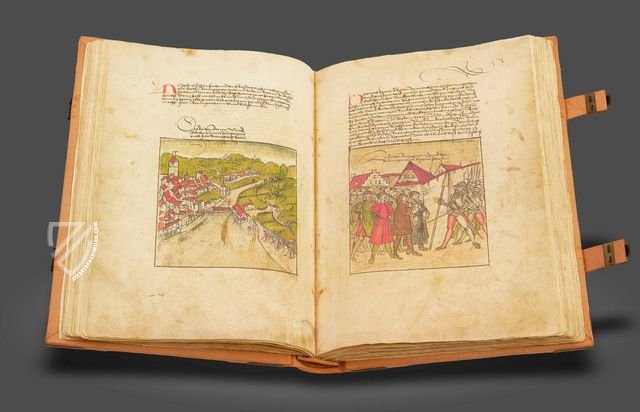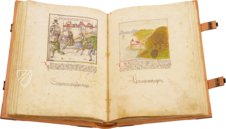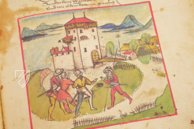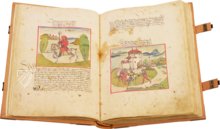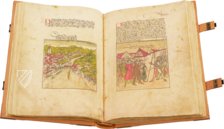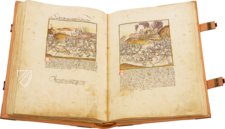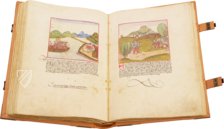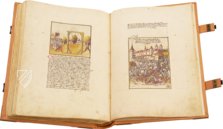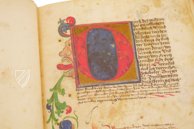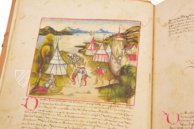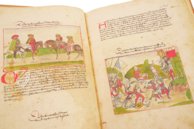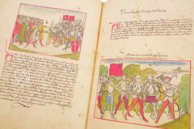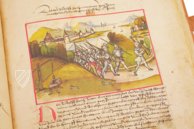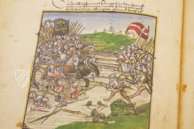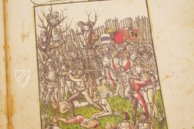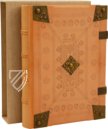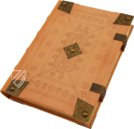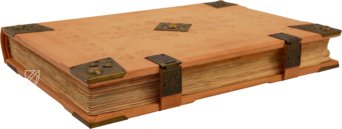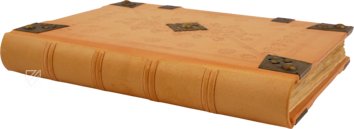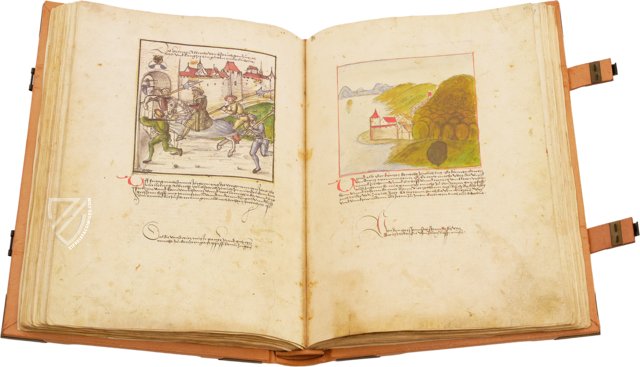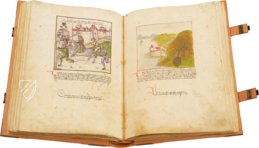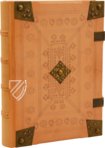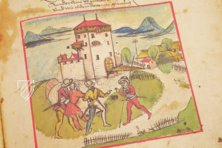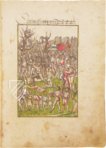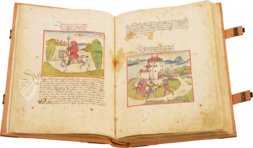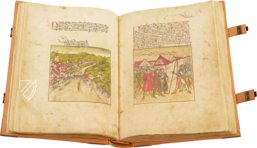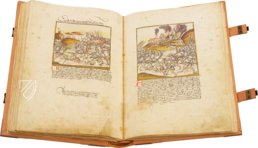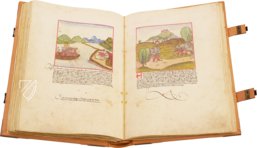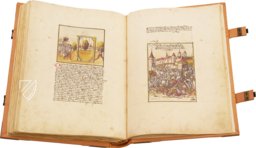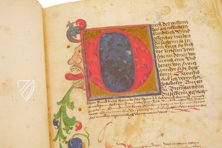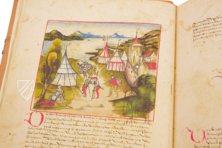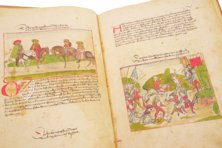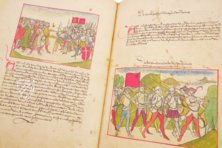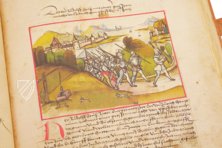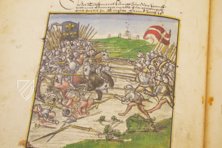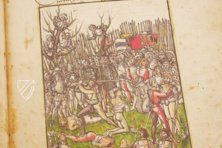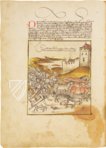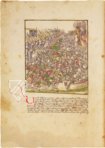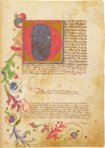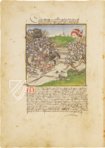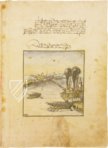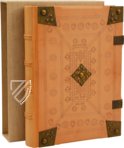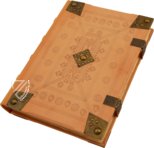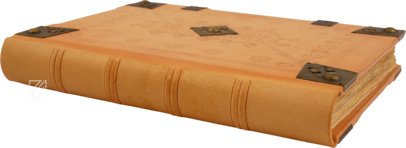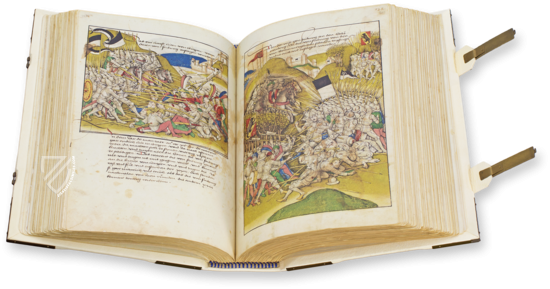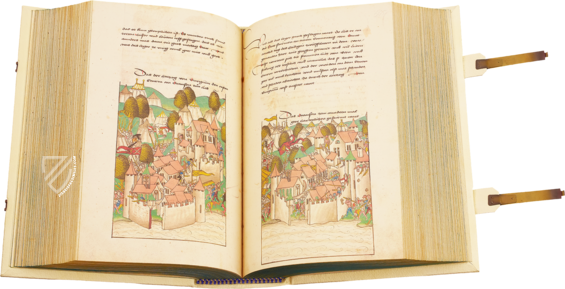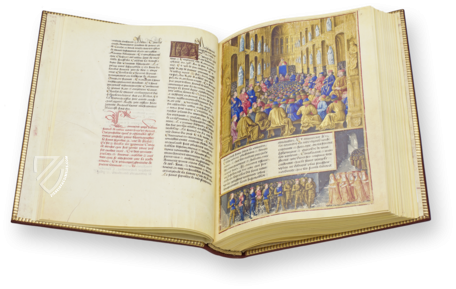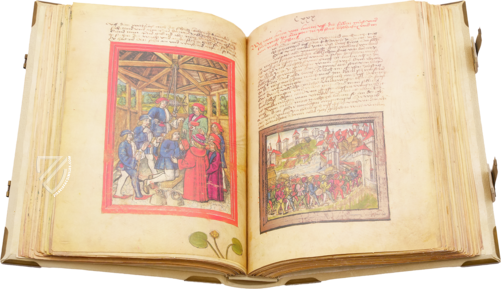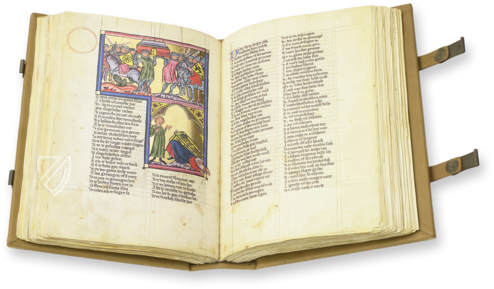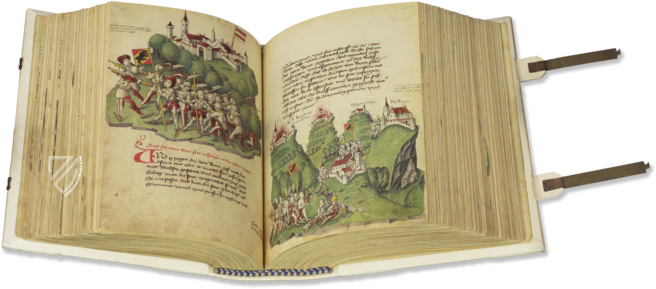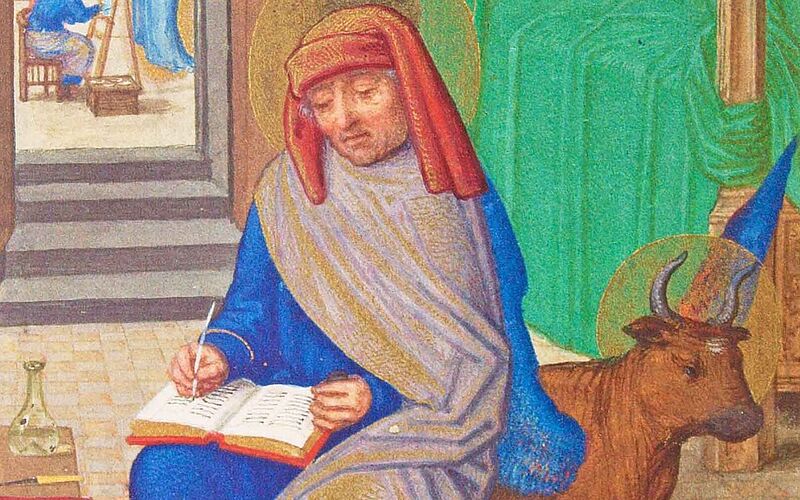Swiss Chronicle of Wernher Schodoler
(1,000€ - 3,000€)
The Swiss Chronicle of Wernher Schodoler is a comprehensive three-volume illustrated chronicle that is considered to be a milestone of Swiss historiography. Previous city chronicles, which were critically reworked here, served as the textual foundation of this ambitious project. Its illustrations show landscapes using perspectives that were completely innovative for the Middle Ages and also document the transition into the book art of the Renaissance. The chronicle is primarily concerned with the development of the Swiss Confederacy, placing special emphasis on the series of wars in the Late Middle Ages that established their reputation for military success as well as their independence from the Holy Roman Empire. At the same time, the 130 pen and ink drawings are a valuable source on everyday life in Switzerland during the period with many details, making the three-volume work a comprehensive historical source, as well as a work of art.
Swiss Chronicle of Wernher Schodoler
The most significant illustrated chronicle from Switzerland comes from the author and illuminator Wernher Schodoler. This work is guided by earlier chronicles, principally the Bern Chronicle by Diebold Schilling. The Swiss Chronicle of Wernher Schodoler consists of three parts. In the first volume, the history of the federation up to the Council of Constance in 1415 is portrayed. The second volume deals with the history of the Old Zurich War and is decorated with numerous color illustrations. The third volume is concerned with the Mühlhausen War, the Burgundian War, the Swabian War, and the Italian Campaign. This volume contains colored drawings, which possess a completely innovative quality that clarifies the methodical transition from the Middle Ages to the Renaissance.
Wernher Schodoler Fulfills his own Dream
The chronicler Schodoler, who was born in the Swiss city of Bremgarten in 1490, came from a highly esteemed family. His forefathers faithfully rendered service to their city municipality. He himself was active in the city council of Bern at the beginning of the 16th century, where he gained insight in to the politics and the valuable chronicles of the city. Furthermore, he participated in multiple military conflicts on behalf of his home. He compiled his Swiss Chronicle not at the wish of his employers, but instead he fulfilled therewith his own desire, namely to record the glorious military events and everyday life of his hometown for his descendants.
Critically Documented History
As a model for his great chronicle, Schodoler used the chronicles of other Swiss authors, above all others he relied upon the works by von Etterlin and Diebold Schiller. He did not incorporate these chronicles without commentary, but rather he critically reworked the models, got rid of unimportant passages or changed them according to his own judgement. He did not shy away from making his opinion known, even when it contradicted his predecessors. In addition, he added his own essays concerning the civil and everyday life of his home and made his corpus into a comprehensive historical source.
The Dawning of a New Age
The illustrations are of great significance to art history, which are found in the three volumes of the chronicle. In the first volume, colored ornamentation is sparingly applied, but the second volume is already decorated with 130 colored pen and ink drawing and golden initials. Schodoler himself belonged to the three illuminators involved here. The illuminators succeeded in recording their keen observation of their surroundings in atmospherically poetic and surprisingly realistic miniatures. In the third volume there are 196 pen and ink drawings with sepia, which originated from an unknown and highly talented illuminator. The artist depicts his landscapes in a completely innovative perspective, lending him depth and breadth that was unusual in the Middle Ages. These depictions of people, who were pertinent to the text, mostly found in martial situations, are of an innovative quality. The human figures, who are supposed to combine the warrior and the artist, mark a new mentality that documents the way from the Middle Ages into the Renaissance.
Codicology
- Alternative Titles
- Eidgenössische Chronik des Wernher Schodoler
Schodoler-Chronik - Size / Format
- 1,048 pages / 39.5 × 29.5 cm
- Origin
- Switzerland
- Date
- Between 1510 and 1535
- Epochs
- Style
- Language
- Script
- Gothic
- Illustrations
- 326 illustrations
- Content
- Chronicle of the development of the Swiss Confederacy
- Artist / School
- Wernher Schodoler
Swiss Chronicle of Wernher Schodoler
Attack on Hurden
During the Old Zurich War, the forces of the imperial city of Zurich clashed with those of the Old Swiss Confederacy from Schwyz and Glarus in the Höfe region on May 22nd, 1443. The Battle of Freienbach is notable inter alia for involving an ambitious attack: on the morning of May 21st, soldiers from Schwyz set the bridge between Hurden and Rapperswil on fire and in response soldiers from Rapperswil immediately boarded two ships to attack Hurden, which is depicted here burning in the aftermath.
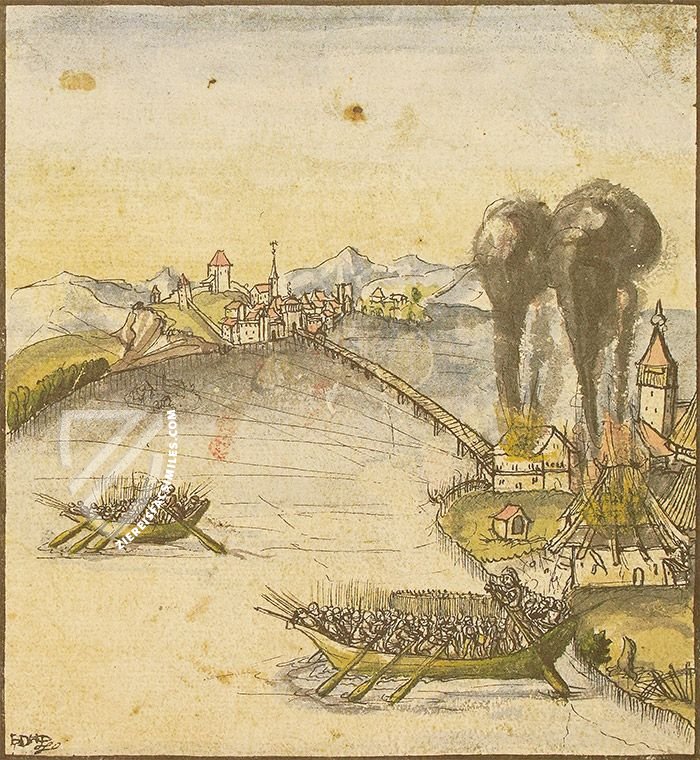
Swiss Chronicle of Wernher Schodoler
Execution of the Defenders of Greifensee
After a four-week long siege, the forces of the Old Swiss Confederacy captured the town of Greifensee on May 27th, 1444. The so-called Murder of Greifensee occurred the next day when all but two of the 64 defenders of Greifensee Castle were beheaded including their leader, Wildhans von Breitenlandenberg. Even in times of war, the mass execution of men who had surrendered was a heinous act.
The executioner readies a blow as the latest victim kneels, his already beheaded comrades lying on the ground. More wait on the right as soldiers from the various confederated cantons watch, their banners and spears filling the background like a forest. To underline their powerlessness, the peasants of Greifensee are depicted small in the foreground.
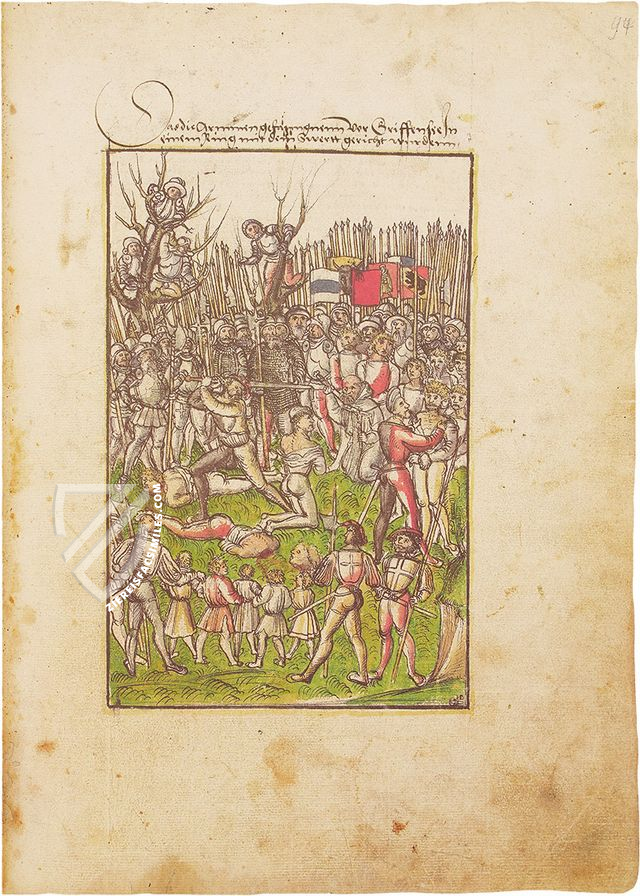
#1 Eidgenössische Chronik des Wernher Schodoler
Language: German
(1,000€ - 3,000€)
- Treatises / Secular Books
- Apocalypses / Beatus
- Astronomy / Astrology
- Bestiaries
- Bibles / Gospels
- Chronicles / History / Law
- Geography / Maps
- Saints' Lives
- Islam / Oriental
- Judaism / Hebrew
- Single Leaf Collections
- Leonardo da Vinci
- Literature / Poetry
- Liturgical Manuscripts
- Medicine / Botany / Alchemy
- Music
- Mythology / Prophecies
- Psalters
- Other Religious Books
- Games / Hunting
- Private Devotion Books
- Other Genres
- Afghanistan
- Armenia
- Austria
- Belgium
- Belize
- Bosnia and Herzegovina
- China
- Colombia
- Costa Rica
- Croatia
- Cyprus
- Czech Republic
- Denmark
- Egypt
- El Salvador
- Ethiopia
- France
- Germany
- Greece
- Guatemala
- Honduras
- Hungary
- India
- Iran
- Iraq
- Israel
- Italy
- Japan
- Jordan
- Kazakhstan
- Kyrgyzstan
- Lebanon
- Liechtenstein
- Luxembourg
- Mexico
- Morocco
- Netherlands
- Palestine
- Panama
- Peru
- Poland
- Portugal
- Romania
- Russia
- Serbia
- Spain
- Sri Lanka
- Sweden
- Switzerland
- Syria
- Tajikistan
- Turkey
- Turkmenistan
- Ukraine
- United Kingdom
- United States
- Uzbekistan
- Vatican City
- A. Oosthoek, van Holkema & Warendorf
- Aboca Museum
- Ajuntament de Valencia
- Akademie Verlag
- Akademische Druck- u. Verlagsanstalt (ADEVA)
- Aldo Ausilio Editore - Bottega d’Erasmo
- Alecto Historical Editions
- Alkuin Verlag
- Almqvist & Wiksell
- Amilcare Pizzi
- Andreas & Andreas Verlagsbuchhandlung
- Archa 90
- Archiv Verlag
- Archivi Edizioni
- Arnold Verlag
- ARS
- Ars Magna
- ArtCodex
- AyN Ediciones
- Azimuth Editions
- Badenia Verlag
- Bärenreiter-Verlag
- Belser Verlag
- Belser Verlag / WK Wertkontor
- Benziger Verlag
- Bernardinum Wydawnictwo
- BiblioGemma
- Biblioteca Apostolica Vaticana (Vaticanstadt, Vaticanstadt)
- Bibliotheca Palatina Faksimile Verlag
- Bibliotheca Rara
- Boydell & Brewer
- Bramante Edizioni
- Bredius Genootschap
- Brepols Publishers
- British Library
- C. Weckesser
- Caixa Catalunya
- Canesi
- CAPSA, Ars Scriptoria
- Caratzas Brothers, Publishers
- Carus Verlag
- Casamassima Libri
- Centrum Cartographie Verlag GmbH
- Chavane Verlag
- Christian Brandstätter Verlag
- Circulo Cientifico
- Club Bibliófilo Versol
- Club du Livre
- CM Editores
- Collegium Graphicum
- Collezione Apocrifa Da Vinci
- Comissão Nacional para as Comemorações dos Descobrimentos Portugueses
- Coron Verlag
- Corvina
- CTHS
- D. S. Brewer
- Damon
- De Agostini/UTET
- De Nederlandsche Boekhandel
- De Schutter
- Deuschle & Stemmle
- Deutscher Verlag für Kunstwissenschaft
- DIAMM
- Droz
- E. Schreiber Graphische Kunstanstalten
- Ediciones Boreal
- Ediciones Grial
- Ediclube
- Edições Inapa
- Edilan
- Editalia
- Edition Deuschle
- Edition Georg Popp
- Edition Leipzig
- Edition Libri Illustri
- Editiones Reales Sitios S. L.
- Éditions de l'Oiseau Lyre
- Editions Medicina Rara
- Editorial Casariego
- Editorial Mintzoa
- Editrice Antenore
- Editrice Velar
- Edizioni Edison
- Egeria, S.L.
- Eikon Editores
- Electa
- Emery Walker Limited
- Enciclopèdia Catalana
- Eos-Verlag
- Ephesus Publishing
- Ernst Battenberg
- Eugrammia Press
- Extraordinary Editions
- Fackelverlag
- Facsimila Art & Edition
- Facsimile Editions Ltd.
- Facsimilia Art & Edition Ebert KG
- Faksimile Verlag
- Feuermann Verlag
- Folger Shakespeare Library
- Franco Cosimo Panini Editore
- Friedrich Wittig Verlag
- Fundación Hullera Vasco-Leonesa
- G. Braziller
- Gabriele Mazzotta Editore
- Gebr. Mann Verlag
- Gesellschaft für graphische Industrie
- Getty Research Institute
- Giovanni Domenico de Rossi
- Giunti Editore
- Graffiti
- Grafica European Center of Fine Arts
- Guido Pressler
- Guillermo Blazquez
- Gustav Kiepenheuer
- H. N. Abrams
- Harrassowitz
- Harvard University Press
- Helikon
- Hendrickson Publishers
- Henning Oppermann
- Herder Verlag
- Hes & De Graaf Publishers
- Hoepli
- Holbein-Verlag
- Houghton Library
- Hugo Schmidt Verlag
- Idion Verlag
- Il Bulino, edizioni d'arte
- ILte
- Imago
- Insel Verlag
- Insel-Verlag Anton Kippenberger
- Instituto de Estudios Altoaragoneses
- Instituto Nacional de Antropología e Historia
- Introligatornia Budnik Jerzy
- Istituto dell'Enciclopedia Italiana - Treccani
- Istituto Ellenico di Studi Bizantini e Postbizantini
- Istituto Geografico De Agostini
- Istituto Poligrafico e Zecca dello Stato
- Italarte Art Establishments
- Jan Thorbecke Verlag
- Johnson Reprint Corporation
- Josef Stocker
- Josef Stocker-Schmid
- Jugoslavija
- Karl W. Hiersemann
- Kasper Straube
- Kaydeda Ediciones
- Kindler Verlag / Coron Verlag
- Kodansha International Ltd.
- Konrad Kölbl Verlag
- Kurt Wolff Verlag
- La Liberia dello Stato
- La Linea Editrice
- La Meta Editore
- Lambert Schneider
- Landeskreditbank Baden-Württemberg
- Leo S. Olschki
- Les Incunables
- Liber Artis
- Library of Congress
- Libreria Musicale Italiana
- Lichtdruck
- Lito Immagine Editore
- Lumen Artis
- Lund Humphries
- M. Moleiro Editor
- Maison des Sciences de l'homme et de la société de Poitiers
- Manuscriptum
- Martinus Nijhoff
- Maruzen-Yushodo Co. Ltd.
- MASA
- Massada Publishers
- McGraw-Hill
- Metropolitan Museum of Art
- Militos
- Millennium Liber
- Müller & Schindler
- Nahar - Stavit
- Nahar and Steimatzky
- National Library of Wales
- Neri Pozza
- Nova Charta
- Oceanum Verlag
- Odeon
- Orbis Mediaevalis
- Orbis Pictus
- Österreichische Staatsdruckerei
- Oxford University Press
- Pageant Books
- Parzellers Buchverlag
- Patrimonio Ediciones
- Pattloch Verlag
- PIAF
- Pieper Verlag
- Plon-Nourrit et cie
- Poligrafiche Bolis
- Presses Universitaires de Strasbourg
- Prestel Verlag
- Princeton University Press
- Prisma Verlag
- Priuli & Verlucca, editori
- Pro Sport Verlag
- Propyläen Verlag
- Pytheas Books
- Quaternio Verlag Luzern
- Reales Sitios
- Recht-Verlag
- Reichert Verlag
- Reichsdruckerei
- Reprint Verlag
- Riehn & Reusch
- Roberto Vattori Editore
- Rosenkilde and Bagger
- Roxburghe Club
- Salerno Editrice
- Saltellus Press
- Sandoz
- Sarajevo Svjetlost
- Schöck ArtPrint Kft.
- Schulsinger Brothers
- Scolar Press
- Scrinium
- Scripta Maneant
- Scriptorium
- Shazar
- Siloé, arte y bibliofilia
- SISMEL - Edizioni del Galluzzo
- Sociedad Mexicana de Antropología
- Société des Bibliophiles & Iconophiles de Belgique
- Soncin Publishing
- Sorli Ediciones
- Stainer and Bell
- Studer
- Styria Verlag
- Sumptibus Pragopress
- Szegedi Tudomànyegyetem
- Taberna Libraria
- Tarshish Books
- Taschen
- Tempus Libri
- Testimonio Compañía Editorial
- Thames and Hudson
- The Clear Vue Publishing Partnership Limited
- The Facsimile Codex
- The Folio Society
- The Marquess of Normanby
- The Richard III and Yorkist History Trust
- Tip.Le.Co
- TouchArt
- TREC Publishing House
- TRI Publishing Co.
- Trident Editore
- Tuliba Collection
- Typis Regiae Officinae Polygraphicae
- Union Verlag Berlin
- Universidad de Granada
- University of California Press
- University of Chicago Press
- Urs Graf
- Vallecchi
- Van Wijnen
- VCH, Acta Humaniora
- VDI Verlag
- VEB Deutscher Verlag für Musik
- Verlag Anton Pustet / Andreas Verlag
- Verlag Bibliophile Drucke Josef Stocker
- Verlag der Münchner Drucke
- Verlag für Regionalgeschichte
- Verlag Styria
- Vicent Garcia Editores
- W. Turnowski Ltd.
- W. Turnowsky
- Waanders Printers
- Wiener Mechitharisten-Congregation (Wien, Österreich)
- Wissenschaftliche Buchgesellschaft
- Wissenschaftliche Verlagsgesellschaft
- Wydawnictwo Dolnoslaskie
- Xuntanza Editorial
- Zakład Narodowy
- Zollikofer AG

